Happy 2024 everyone!
To kick off the new year, I’ve decided to share only positive, uplifting stories in this week’s roundup. Here goes…
The thought that counts: A basketball superstar who plays for the Dallas Mavericks gave all his teammates new e-bikes for Christmas. Let’s hope they make riding a habit! (Dallas Morning News)
US cycling hopes: Rising professional racing star Sepp Kuss is the hero American cycling deserves a decade after Lance Armstrong ripped all of our hearts out. Can he spark a return to glory for the US on the world stage? (Cycling Weekly)
Resolve to make streets better: If you’re a new policymaker or elected and want a cheat-sheet for how to orient your work in the new year, here are eight ideas to print out and display next to your computer. (Streetsblog USA)
Relatable Rigo: I had no idea how beloved pro cyclist Rigoberto Urán is in Colombia. Dude has a telenova on Netflix and 5,000 people show up to his “Giro de Rigo” ride! (NPR)
E-bike rebates work: The wild success of e-bike purchase incentives in Colorado have cemented them into state law and should be clarion call for Oregon lawmakers who say they care about transportation and the the health of Oregonians. (Colorado Public Radio)
Transit growth: The Puget Sound area is poised for a banner year of new bus service, light rail lines, and more transit improvements. (The Urbanist)
The future of carsharing: If you believe shared cars are key to a low-car lifestyle, don’t miss this excellent history of carsharing in the US and its recommendations for the future. (Tyler Phillipi on Linkedin)
Bike whisperer: A vigilante in Reykjavík has become a hub for helping people recover stolen bikes and has used relationships with bike thieves to help his cause. (The Guardian)
Thanks to everyone who sent in links this week. The Monday Roundup is a community effort, so please feel free to send us any great stories you come across.


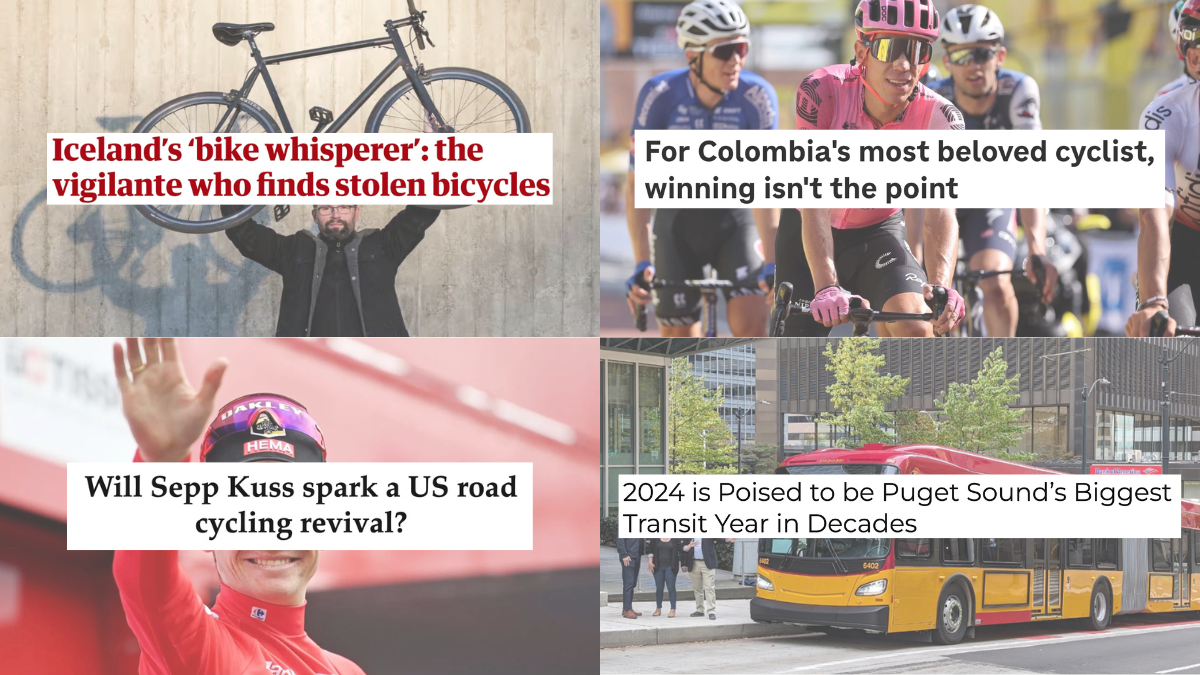
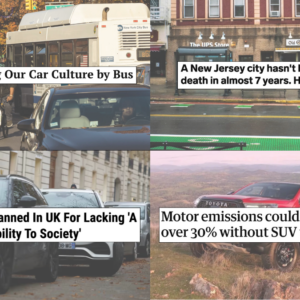
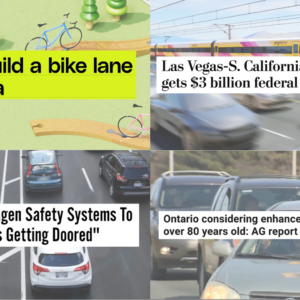
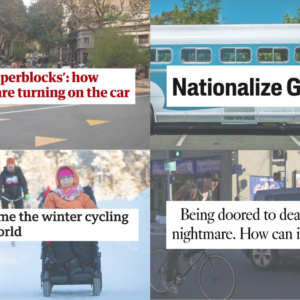
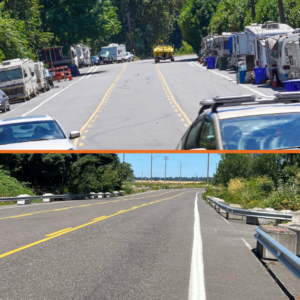
Thanks for reading.
BikePortland has served this community with independent community journalism since 2005. We rely on subscriptions from readers like you to survive. Your financial support is vital in keeping this valuable resource alive and well.
Please subscribe today to strengthen and expand our work.
The link for the Colorado Public Radio story goes to another, albeit related item. We demand our Colorado Public Radio link!!!
https://www.cpr.org/2023/12/28/colorado-ebike-program-funding/
Sorry Lois! Fixed it. https://www.cpr.org/2023/12/28/colorado-ebike-program-funding/
Maybe.
Colorado seems to have demonstrated that people will apply for rebates, but (to me at least) it really only matters if folks use their bikes to displace auto travel in a way they would not have absent the rebate, and to a level that makes the public expenditure worthwhile.
It’s probably too soon to tell, but the story doesn’t mention any plans to study that.
You make a good point here, Watts. I’m the only person in my neighborhood who ever rides a bike anywhere, from what I can tell. How I would love to see one – just ONE – person besides me on a bike, going to the Plaid Pantry or post office or wherever.
“E-bike rebates work: The wild success of e-bike purchase incentives in Colorado have cemented them into state law and should be clarion call for Oregon lawmakers who say they care about transportation and the the health of Oregonians. (Colorado Public Radio)”
Whoa! If we truly care about public health wouldn’t we subsidize standard bikes instead of e-bikes? It seems many of the e-bikes are nothing more than small electric motorcycles with pedals attached. A lot more health benefits from true human powered transportation.
Well, it’s more complicated. I have an e-bike as well as a regular bike. I ride the regular bike for exercise, errands, and commuting, but there are some days when I’m too tired or the route is too hilly, or I have to look “professional” at the end of the ride so the e-bike is good in these cases.
I agree that the e-bike doesn’t provide “real” exercise in the way a regular bike does. But if it’s a choice between someone riding an e-bike and not biking at all, then I say it’s still in the public interest to promote e-biking. Every car trip replaced by an e-bike trip is still a win for all of us.
While an e-bike doesn’t provide “real” exercise in the way a regular bike does, it can just as much provide “real” exercise. One can work just as hard on an e-bike as they do a non-e-bike if they choose. I assume most e-bike riders don’t make that choice, but it’s definitely possible.
I usually keep the assist off until I’m on my way home. I want the exercise getting there, but I want to get home easily at the end of the day. It’s all pedaling either way.
When I first got my ebike, I tried to use my ebike for only long rides and difficult routes I wouldn’t normally take my regular bikes on, I really did, but pretty quickly I was using my ebike for EVERY ride, even short rides to the grocery – it was just too easy, made me feel 16 again, etc. But after 6 months and 1500 miles, my bike frame broke (in the collar/seat tube area, long story) and so I had to switch back to my regular bikes. And yeah, I noticed a huge difference switching back – I sweat far more, I get a lot more exercise, burn far more calories, drink a lot more water, don’t go as far as easily, my blood sugars drop a lot more (a good thing, that!). But you know what the biggest change is? My parts don’t wear out as fast – I don’t have to keep tightening my cranks every week, spokes no longer break, no more plugging in the bike and worrying if there’s enough power in it.
Most of the people I know with ebikes are people who had regular bikes before – very few are ever new riders.
In my estimation, with a mid-drive pedal-assist motor and no throttle, I got roughly 66%-75% of the exercise on a 57 lb ebike as compared to a highly-efficient 30 lb non-ebike. Long-term I’m much better off healthwise not using an ebike at all.
Still thinking of a Swytch though…
Man the East Link project is a mess. Not having enough yard space to run the most important part of the network (the segment north of Seattle) is really bad, but it’s also disappointing that Sound Transit hasn’t pursued more creative options. In New York, there isn’t enough yard space to store all the subway trains since 24/7 service has been the norm for so long. Yet Sound Transit uses overnight cleaning and maintenance as a reason to not do this. I find it hard to believe that they couldn’t find a way to operationalize 24/7 service temporarily to open the Lynwood extension early (though it is difficult to know if that alone would be enough to make a difference or not).
But this all shows how brittle these plans are. Sound Transit has one maintenance facility! Maybe building a second one on the other side of a floating rail bridge – a highly unusual, maybe entirely unique and unproven piece of infrastructure is not good planning.
And this same kind of non-operationally minded planning plagues us here in Portland too. The Orange Line project added yard space to Ruby Junction out in Gresham rather than creating a new yard or minor facility elsewhere. This decision also (likely) created the weird 291 Orange night bus, since the yard facilities are so far away. And ever wonder why frequent service starts so late in the day on the Orange line (around 8:30 in the morning)? It’s because of operational constraints in spinning up more service with the yard being 16 miles away.
Maybe the Orange and Green lines are supposed to get together on the S end some time? (Save the date!) Meanwhile it all depends on the Steel Bridge. It’s just yards from the ODOT office but doesn’t carry the right kind of transportation I guess. It is an old bridge that bottlenecks a lot of expensive infrastructure.
Seattle is actually worrying about their new transit lines being overcrowded.
Yeah at one point they were planned to meet at CTC, with what is now the Orange line following the Milwaukie Expressway but I think the general “plan” (that isn’t really a plan at all anymore as far as I can tell) is to meet in Oregon City. Which we can expect to be completed a few weeks before the heat death of the universe.
The Steel Bridge is a bottleneck, but is something that needs to be addressed in a different project (ideally a tunnel for the whole of the MAX downtown). Even if it were addressed, the lack of yard space for the Orange and Yellow lines is still going to be an issues – and one they should have solved during the construction of the Orange line. The center street garage could have been expanded or altered for a light maintenance facility fairly easily, and it’s a shame that it wasn’t.
And haven ridden a fair few extremely crowded Link trains, it’s hard to even start with how many changes in scope the system needs. Light rail was always a bad choice for a regional metro!
I think the new yard and additional improvements to the Steel Bridge were going to be done as part of the original CRC project and Vancouver Max extension.
I haven’t looked to see if they are being packaged in the new IBR project.
How are the Orange Line trains getting to/from their Gresham storage facility during the closure of the Red Line?
Presumably TriMet has some contingency plans, either storing more of the fleet at Elmonica or doing the upgrades/maintenance in a way where they can still do non-revenue moves for getting trains into service. Maybe some of both, but they surely need to do the latter to get trains to serve the green line stub. But considering that service levels will be way lower during the closure, maybe there are enough trains just at Elmonica